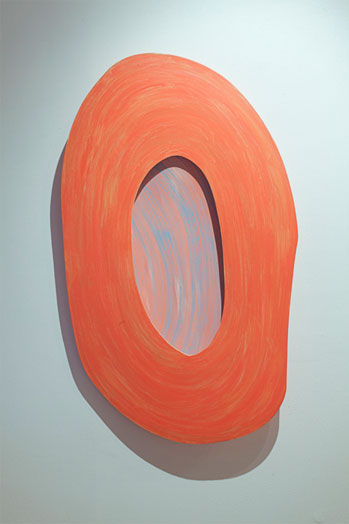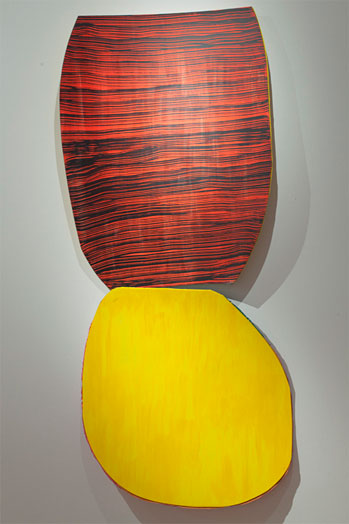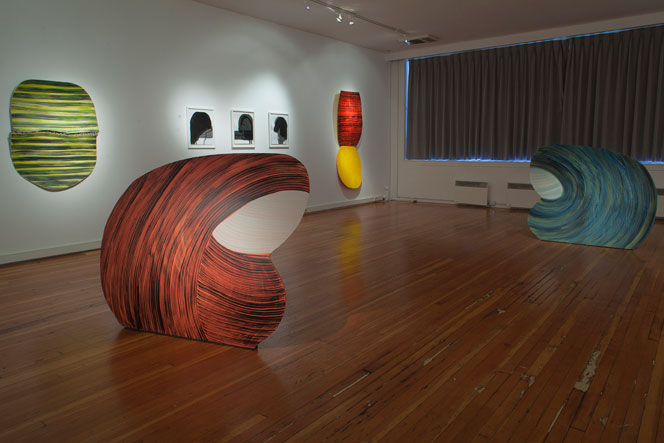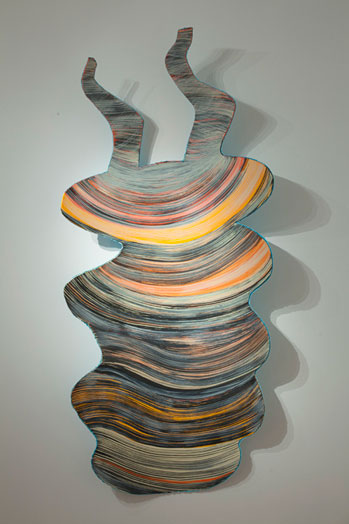Lyse Lemieux: Shaped Drawings: something wrong about the mouth
When John Singer Sargent said, "A portrait is a painting with a little something wrong about the mouth," he made a complex, puzzling statement. Was he simply making a neutral observation, or was he talking about their relative value as art? Was it that a portrait is a slightly degraded form of art from a painting; or that a portrait is the more accurate picture of reality, and a painting a corrected, hence idealized, abstracted version? What he definitely did was identify how minute the distinction could be between representation and abstraction. On a continuum between the two, Sargent would be at the representative end. Lemieux plays in that small space where abstraction, process and materiality leans into representation. Helped along by suggestive titles like Red with Open Mouth, and Red and Yellow Figure with Orange Fabric, what look at first like large abstract shapes slowly resolve themselves into loose figuration.
A collection of drawings, most from 2010 and 2011 and mainly framed, show where Lemieux's current drawings come from. The restraint of the earlier work in size and material is dramatically changed in the new which are generally increased in scale, out of their frames, colorful, and partially peeled from the wall, making their backsides accessible. These are either painted or covered in various fabrics, the colors mixing with the shadows on the wall behind. Partially revealing the rear teasingly accentuates the fact that there is another side or view, and is given to producing the same sort of frustration as trying to see the backside of sculpture in the round when it's pushed to a wall or placed in a niche.
A collection of drawings, most from 2010 and 2011 and mainly framed, show where Lemieux's current drawings come from. The restraint of the earlier work in size and material is dramatically changed in the new which are generally increased in scale, out of their frames, colorful, and partially peeled from the wall, making their backsides accessible. These are either painted or covered in various fabrics, the colors mixing with the shadows on the wall behind. Partially revealing the rear teasingly accentuates the fact that there is another side or view, and is given to producing the same sort of frustration as trying to see the backside of sculpture in the round when it's pushed to a wall or placed in a niche.
Philip Guston and Louise Bourgeois are two strong influences on Lemieux and both are represented. Two versions of Guston's large, roaming head of the artist (HEAD LINES: Looking left at P. Guston and HEAD LINES: Looking right at P. Guston) come right off the wall and stand propped up like signboards in the middle of the room. Both sides are readily accessible, but there is no mistaking which is the dominant view because one, the subordinate, is painted a single color and is partially obstructed by the support. The material thickness of these drawings is the same thin foam core as the large drawings on the wall, but the props are made of angle-iron. Using so unnecessarily robust a material to support something so light makes its discovery comical and Gustonesque, the more so if it's the weight of metaphor that they're carrying.
Lemieux's tip of the hat to Bourgeois is her Upside Down Spiral Woman (LB) drawn from the many variations Borgeois did of her Spiral Woman. Like most the rest of the new drawings, aside from the suggestion of eyes on the HEAD LINES, there are no internal figurative indicators, just outlines; and in the case of Guston and Bourgeois, unmistakable.
Lemieux's use of fabric on the backs of some drawings (Upside Down Spiral Woman (LB) has a pale blue chenile with fuzzy, raised polka dots), and as connective tissues between others (gauze connects the circular front with the rear plane of Red with Open Mouth), introduces a physicality and tactility that is slightly at odds, and hence creates a tension with, the rather flat, graphic, nature of Lemieux's painting.
Though the show makes the round from drawings that are framed and flat, through unframed and peeling from the wall, to freestanding on the floor, the feeling is not one of a strong impulse towards sculpture on the part of Lemieux; that impulse remains resolutely in the field of drawing.
The cuts of the knife which define the outlines of the shapes are lines in space, the same as drawn lines. Where drawn lines give definition against a two dimensional background of paper, for instance, the cut lines give definition against the background of the physical world. This might be splitting hairs, but they're hairs that Lemieux wants to split, as seen in her consistent reference to her work as "drawings."
Giving support to her new drawings as drawings, and not paintings, is Lemieux's application of materials which is more graphic than painterly. The color is broadly and briskly applied, and her overlay of heavy black strokes of ink give the effect of illustrations of giant brush strokes.
Lemieux describes Bourgeois's work as helping us "travel comfortably between what we know, what we think we know and what we think she wants us to know." Lemieux's new drawings do the same for the gap between figure and abstraction, and drawing and sculpture, but with a pleasant frisson that I'm sure Bourgeois would appreciate.
First published with www.twocoatsofpaint.
Lemieux's use of fabric on the backs of some drawings (Upside Down Spiral Woman (LB) has a pale blue chenile with fuzzy, raised polka dots), and as connective tissues between others (gauze connects the circular front with the rear plane of Red with Open Mouth), introduces a physicality and tactility that is slightly at odds, and hence creates a tension with, the rather flat, graphic, nature of Lemieux's painting.
Though the show makes the round from drawings that are framed and flat, through unframed and peeling from the wall, to freestanding on the floor, the feeling is not one of a strong impulse towards sculpture on the part of Lemieux; that impulse remains resolutely in the field of drawing.
The cuts of the knife which define the outlines of the shapes are lines in space, the same as drawn lines. Where drawn lines give definition against a two dimensional background of paper, for instance, the cut lines give definition against the background of the physical world. This might be splitting hairs, but they're hairs that Lemieux wants to split, as seen in her consistent reference to her work as "drawings."
Giving support to her new drawings as drawings, and not paintings, is Lemieux's application of materials which is more graphic than painterly. The color is broadly and briskly applied, and her overlay of heavy black strokes of ink give the effect of illustrations of giant brush strokes.
Lemieux describes Bourgeois's work as helping us "travel comfortably between what we know, what we think we know and what we think she wants us to know." Lemieux's new drawings do the same for the gap between figure and abstraction, and drawing and sculpture, but with a pleasant frisson that I'm sure Bourgeois would appreciate.
First published with www.twocoatsofpaint.




